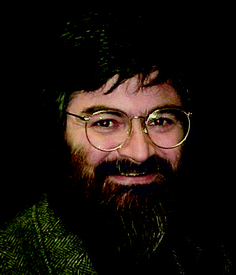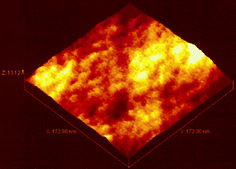Luis A. Colón, University at Buffalo†
Abstract
The Analyst profiles its Editor for the Americas, Professor Luis Colón
 Luis Colón was born in Cidra, Puerto Rico. He received a BSc (Magna Cum Laude) in Chemistry from the University of Puerto Rico at Cayey, after which he worked in a pharmaceutical company in Humacao, Puerto Rico (Syntex, F.P., Inc.) as Senior Chemist for five years. He obtained a PhD in Analytical Chemistry from the University of Massachusetts at Lowell in 1991 and was a Postdoctoral Associate at Stanford University from 1991 to 1993. Since that time he has been Assistant Professor of Chemistry at the University at Buffalo. His current research interests focus on three main themes: (1) chemical analysis in the micron and sub-micron scale; (2) column technology for HPLC and capillary electrochromatography; and (3) the development of non-invasive sampling for clinical diagnosis. Since January 2001, Luis has been The Analyst’s Editor for The Americas.What early influences encouraged you to take up science?
Luis Colón was born in Cidra, Puerto Rico. He received a BSc (Magna Cum Laude) in Chemistry from the University of Puerto Rico at Cayey, after which he worked in a pharmaceutical company in Humacao, Puerto Rico (Syntex, F.P., Inc.) as Senior Chemist for five years. He obtained a PhD in Analytical Chemistry from the University of Massachusetts at Lowell in 1991 and was a Postdoctoral Associate at Stanford University from 1991 to 1993. Since that time he has been Assistant Professor of Chemistry at the University at Buffalo. His current research interests focus on three main themes: (1) chemical analysis in the micron and sub-micron scale; (2) column technology for HPLC and capillary electrochromatography; and (3) the development of non-invasive sampling for clinical diagnosis. Since January 2001, Luis has been The Analyst’s Editor for The Americas.What early influences encouraged you to take up science?One of the first sparks that ignited my interest in science was in fifth grade, in a small elementary school in the town of Cidra, Puerto Rico. My teacher was introducing some chemical concepts through a few simple experiments. One experiment that fascinated me was the formation of silver sulfide on a silver spoon. The experiment consisted of having a small quantity of cooked egg yolk on a plate. The egg yolk was then covered with a very shiny polished silver spoon. An hour or so later, I noticed how the portion of the spoon in contact with the egg yolk became dark, while the rest of the spoon still was shining. The teacher then explained to us what was going on—two elements, silver and sulfur, combined to form the compound silver sulfide. It was fascinating not just to see the color changed but to learn that there was an explanation for what occurred and it was so simple. That made me become more curious about my surroundings, trying to understand why or how things are the way they are.
Tell us about your current projects and why you chose to research these areas?I have always been interested in the area of separation sciences. (In retrospect, perhaps since I was a kid, when I saw my father separating the dried skins from the almost ready to roast coffee beans. Interestingly, he used to throw the mixture up into the air and as the wind blew, it took away the dried skins, while the coffee beans returned back to the original container.) Studying the complexity of a natural system (e.g., a microorganism, a single cell, or an ecosystem) is challenging and very fascinating at the same time. It may entail identification and quantification of various chemical components present in a given system, which in turn may lead to the elucidation of a particular process or pathway in the system. This requires the development of technology that is appropriate for the task; separation sciences are a ‘centerpiece” in such a task.

My research group focuses on investigating new methodologies and technologies for chemical analysis, especially separation sciences. One area of interest has been the implementation of fast separation methodology, with potential applicability in the pharmaceutical industry, proteomics, and to environmental problems. We have also been investigating new approaches to column technology for HPLC and capillary electrochromatography (CEC), from column packing methodologies to the synthesis of new chromatographic materials (e.g., particles, monoliths, thin films). For example, using sol-gel processing, we synthesize silica-based organic–inorganic hybrids, as well as other non-silica materials, and investigate their physicochemical characteristics and how such characteristics influence chemical separations when used as chromatographic media. Another area of investigation deals with the use of small particle size materials (≤ 1 μm) in HPLC and CEC and its practicality. We are also interested in new strategies to analyze environments in small domains. One area of particular interest is the protein–drug interaction at the cellular and subcellular levels, and the analysis of biofluids, present in small quantities, such as tear fluid.
You received the National Science Foundation Award for Special Creativity in 2000–01. Tell us about thatThis award consists of an extension of funding for a research grant beyond the initial period for which the grant was awarded. As stated by the National Science Foundation (NSF) “the objective of such extensions is to offer the most creative investigators an extended opportunity to attack adventurous, ’high-risk’ opportunities in the same general research area, but not necessarily covered by the original/current proposal”. These Special Creativity Extensions are based on progress during the first two years of a three-year grant and start with the recommendation of an NSF program officer.
What is your finest moment?One piece of work that I have been very pleased with is the work carried out on silica hybrids. Our first publication on the subject dealt with the synthesis of silica-based organic–inorganic thin films as stationary phases for open tubular liquid chromatography and electrochromatography (Anal. Chem., 1995, 67, 2511–2516). Subsequently, we reported very interesting NMR studies on the chemistry of the sol-gel hybrid solution leading to the final hybrid materials (Chem. Mater., 1999, 11, 754–762; Appl. Spectrosc., 2001, 55, 472–480).
 Last year saw the celebration of 100 years of chromatography. What do you think next century’s challenges in the separation sciences will be?
Last year saw the celebration of 100 years of chromatography. What do you think next century’s challenges in the separation sciences will be?Perhaps in 1904 it would have been very difficult to foresee how far one could go with a technique introduced to separate plant pigments. It would be difficult to predict what challenges we will face in the distant future. Many separation challenges have come through the years and because of the dynamic nature of the discipline, they have been addressed. As these challenges are addressed, we take upon new ones. Take, for example, the Human Genome project, where electrophoresis played a pivotal role in the separation of DNA base pairs; now we take on the complexity of proteomics. Here, separation sciences are faced with the challenge of multiplexing. Fast, multidimensional separation methods are needed and in many cases, combined, with parallel approaches. Bringing this to routine analysis, with validated protocols, constitutes part of the challenge. Another part of the challenge is the development of separation methodology to analyze very small environments, to parallel the advances in understanding of the sub-cellular processes.
Last year you received ‘Mentor of the Year Award’ from the Alliance for Graduate Education and the Professoriate Program. What makes a good mentor?We as scientists (and teachers) emphasize scientific integrity and advise on the different scientific endeavours associated with a research problem. Our associates do learn to be inquisitive from the way we attack a scientific problem. In my opinion, however, mentorship goes beyond the scientific aspects of our profession; it is a philosophy toward life in general, which is reflected in our daily work. Appreciation and understanding have been key factors in my personal experience with my research group. My office has always been open to my associates to come and talk, not just about research but about other challenges they are encountering. I think it is important to acknowledge that they are doing great work. At the same time, a mentor needs to point out wisely and with respect areas that need improvement. Being in contact and sharing the excitement of an experimental result creates an enthusiasm and a passion for what is being done that can be contagious. A sense of being a comrade will always maintain a good spirit in the research group and encourages trust. In mentoring, it is important to remember that, in one way or another, we all have been in a similar position at some point in our lives.
 Which part of your role as Editor for the Americas for The Analyst do you enjoy the most and like the least?
Which part of your role as Editor for the Americas for The Analyst do you enjoy the most and like the least?I enjoy meeting new people and learning about their work. Being the Editor has given me the opportunity to learn more about other research groups and what they do. It is always exciting to learn about the latest findings in science by reading through the new manuscripts. Perhaps the least pleasant part of being Editor is reminding referees to turn in their reports.
Over one third of papers published in The Analyst originate from North America. What do you think publishing in The Analyst offers American and Canadian authors?The Analyst offers an international forum to publish high quality work in the analytical sciences. It is an excellent place to report advances in all branches of analytical sciences, particularly in the areas of nanoscience, miniaturization, and bioanalytical chemistry. The international audience enjoys very high quality papers, as only the top 30% of the manuscripts received are published. The editorial office provides outstanding service. The manuscript turn around is very rapid, which accelerates the dissemination of the most recent advances in the analytical sciences.
To submit an article for publication to Prof. Colón visit the e-submissions web site at http://www.rsc.org/esubmissions.For more on research in the Colón group visit http://www.chem.buffalo.edu/colon/index.html.
Footnote |
| † Photographs (from top) show (1) Prof. Colón, (2) organo-silica nano-particles used in ultrahigh-pressure liquid chromatography (3) AFM image of a thin film of organo-silica hybrid chromatographic material, and (4) the Colón group. |
| This journal is © The Royal Society of Chemistry 2004 |
